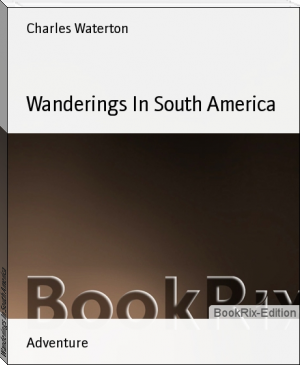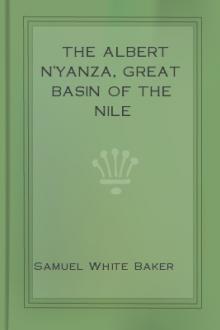Wanderings In South America, Charles Waterton [phonics reader txt] 📗

- Author: Charles Waterton
Book online «Wanderings In South America, Charles Waterton [phonics reader txt] 📗». Author Charles Waterton
PREFACE TO THE FIRST EDITION
I offer this book of "Wanderings" with a hesitating hand. It has little merit, and must make its way through the world as well as it can. It will receive many a jostle as it goes along, and perhaps is destined to add one more to the number of slain in the field of modern criticism. But if it fall, it may still, in death, be useful to me; for should some accidental rover take it up and, in turning over its pages, imbibe the idea of going out to explore Guiana in order to give the world an enlarged description of that noble country, I shall say, "fortem ad fortia misi," and demand the armour; that is, I shall lay claim to a certain portion of the honours he will receive, upon the plea that I was the first mover of his discoveries; for, as Ulysses sent Achilles to Troy, so I sent him to Guiana. I intended to have written much more at length; but days and months and years have passed away, and nothing has been done. Thinking it very probable that I shall never have patience enough to sit down and write a full account of all I saw and examined in those remote wilds, I give up the intention of doing so, and send forth this account of my "Wanderings" just as it was written at the time.
If critics are displeased with it in its present form, I beg to observe that it is not totally devoid of interest, and that it contains something useful. Several of the unfortunate gentlemen who went out to explore the Congo were thankful for the instructions they found in it; and Sir Joseph Banks, on sending back the journal, said in his letter: "I return your journal with abundant thanks for the very instructive lesson you have favoured us with this morning, which far excelled, in real utility, everything I have hitherto seen." And in another letter he says: "I hear with particular pleasure your intention of resuming your interesting travels, to which natural history has already been so much indebted." And again: "I am sorry you did not deposit some part of your last harvest of birds in the British Museum, that your name might become familiar to naturalists and your unrivalled skill in preserving birds be made known to the public." And again: "You certainly have talents to set forth a book which will improve and extend materially the bounds of natural science."
Sir Joseph never read the third adventure. Whilst I was engaged in it, death robbed England of one of her most valuable subjects and deprived the Royal Society of its brightest ornament.
CONTENTS
INTRODUCTION
PREFACE TO THE FIRST EDITION
FIRST JOURNEY REMARKS
SECOND JOURNEY
THIRD JOURNEY
FOURTH JOURNEY
ON PRESERVING BIRDS FOR CABINETS OF NATURAL HISTORY
GLOSSARY
INDEX
WANDERINGS IN SOUTH AMERICA
FIRST JOURNEY
----nec herba, nec latens in asperis Radix fefellit me locis.
In the month of April 1812 I left the town of Stabroek to travel through the wilds of Demerara and Essequibo, a part of _ci-devant_ Dutch Guiana, in South America.
The chief objects in view were to collect a quantity of the strongest wourali poison and to reach the inland frontier-fort of Portuguese Guiana.
It would be a tedious journey for him who wishes to travel through these wilds to set out from Stabroek on foot. The sun would exhaust him in his attempts to wade through the swamps, and the mosquitos at night would deprive him of every hour of sleep.
The road for horses runs parallel to the river, but it extends a very little way, and even ends before the cultivation of the plantations ceases.
The only mode then that remains is to proceed by water; and when you come to the high-lands, you may make your way through the forest on foot or continue your route on the river.
After passing the third island in the River Demerara there are few plantations to be seen, and those not joining on to one another, but separated by large tracts of wood.
The Loo is the last where the sugar-cane is growing. The greater part of its negroes have just been ordered to another estate, and ere a few months shall have elapsed all signs of cultivation will be lost in underwood.
Higher up stand the sugar-works of Amelia's Waard, solitary and abandoned; and after passing these there is not a ruin to inform the traveller that either coffee or sugar have ever been cultivated.
From Amelia's Waard an unbroken range of forest covers each bank of the river, saving here and there where a hut discovers itself, inhabited by free people of colour, with a rood or two of bared ground about it; or where the wood-cutter has erected himself a dwelling and cleared a few acres for pasturage. Sometimes you see level ground on each side of you for two or three hours at a stretch; at other times a gently sloping hill presents itself; and often, on turning a point, the eye is pleased with the contrast of an almost perpendicular height jutting into the water. The trees put you in mind of an eternal spring, with summer and autumn kindly blended into it.
Here you may see a sloping extent of noble trees whose foliage displays a charming variety of every shade, from the lightest to the darkest green and purple. The tops of some are crowned with bloom of the loveliest hue, while the boughs of others bend with a profusion of seeds and fruits.
Those whose heads have been bared by time or blasted by the thunderstorm strike the eye, as a mournful sound does the ear in music, and seem to beckon to the sentimental traveller to stop a moment or two and see that the forests which surround him, like men and kingdoms, have their periods of misfortune and decay.
The first rocks of any considerable size that are observed on the side of the river are at a place called Saba, from the Indian word which means a stone. They appear sloping down to the water's edge, not shelvy, but smooth, and their exuberances rounded off and, in some places, deeply furrowed, as though they had been worn with continual floods of water.
There are patches of soil up and down, and the huge stones amongst them produce a pleasing and novel effect. You see a few coffee-trees of a fine luxuriant growth, and nearly on the top of Saba stands the house of the post-holder.
He is appointed by Government to give in his report to the protector of the Indians of what is going on amongst them and to prevent suspicious people from passing up the river.
When the Indians assemble here, the stranger may have an opportunity of seeing the aborigines dancing to the sound of their country music and painted in their native style. They will shoot their arrows for him with an unerring aim and send the poisoned dart, from the blow-pipe, true to its destination: and here he may often view all the different shades, from the red savage to the white man; and from the white man to the sootiest son of Africa.
Beyond this post there are no more habitations of white men or free people of colour.
In a country so extensively covered with wood as this is, having every advantage that a tropical sun and the richest mould, in many places, can give to vegetation, it is natural to look for trees of very large dimensions. But it is rare to meet with them above six yards in circumference. If larger have ever existed they have fallen a sacrifice either to the axe or to fire.
If, however, they disappoint you in size, they make ample amends in height. Heedless, and bankrupt in all curiosity, must he be who can journey on without stopping to take a view of the towering mora. Its topmost branch, when naked with age or dried by accident, is the favourite resort of the toucan. Many a time has this singular bird felt the shot faintly strike him from the gun of the fowler beneath, and owed his life to the distance betwixt them.
The trees which form these far-extending wilds are as useful as they are ornamental. It would take a volume of itself to describe them.
The green-heart, famous for its hardness and durability; the hackea for its toughness; the ducalabali surpassing mahogany; the ebony and letter-wood vying with the choicest woods of the old world; the locust-tree yielding copal; and the hayawa- and olou-trees furnishing a sweet-smelling resin, are all to be met with in the forest betwixt the plantations and the rock Saba.
Beyond this rock the country has been little explored, but it is very probable that these, and a vast collection of other kinds, and possibly many new species, are scattered up and down, in all directions, through the swamps and hills and savannas of _ci-devant_ Dutch Guiana.
On viewing the stately trees around him, the naturalist will observe many of them bearing leaves and blossoms and fruit not their own.
The wild fig-tree, as large as a common English apple-tree, often rears itself from one of the thick branches at the top of the mora, and when its fruit is ripe, to it the birds resort for nourishment. It was to an undigested seed passing through the body of the bird which had perched on the mora that the fig-tree first owed its elevated station there. The sap of the mora raised it into full bearing, but now, in its turn, it is doomed to contribute a portion of its own sap and juices towards the growth of different species of vines, the seeds of which also the birds deposited on its branches. These soon vegetate, and bear fruit in great quantities; so what with their usurpation of the resources of the fig-tree, and the fig- tree of the mora, the mora, unable to support a charge which nature never intended it should, languishes and dies under its burden; and then the fig- tree, and its usurping progeny of vines, receiving no more succour from their late foster-parent, droop and perish in their turn.
A vine called the bush-rope by the wood-cutters, on account of its use in hauling out the heaviest timber, has a singular appearance in the forests of Demerara. Sometimes you see it nearly as thick as a man's body, twisted like a corkscrew round the tallest trees and rearing its head high above their tops. At other times three or four of them, like strands in a cable, join tree and tree and branch and branch together. Others, descending from on high, take root as soon as their extremity touches the ground, and appear like shrouds and stays supporting the mainmast of a line-of-battle ship; while others, sending out parallel, oblique, horizontal and perpendicular shoots in all directions, put you in mind of what travellers call a matted forest. Oftentimes a tree, above a hundred feet high, uprooted by the whirlwind, is stopped in its fall by these amazing cables of nature, and hence it is that you account for the phenomenon of seeing trees not only vegetating, but sending forth vigorous shoots, though far from their perpendicular, and their trunks inclined to every degree from the meridian to the horizon.





Comments (0)